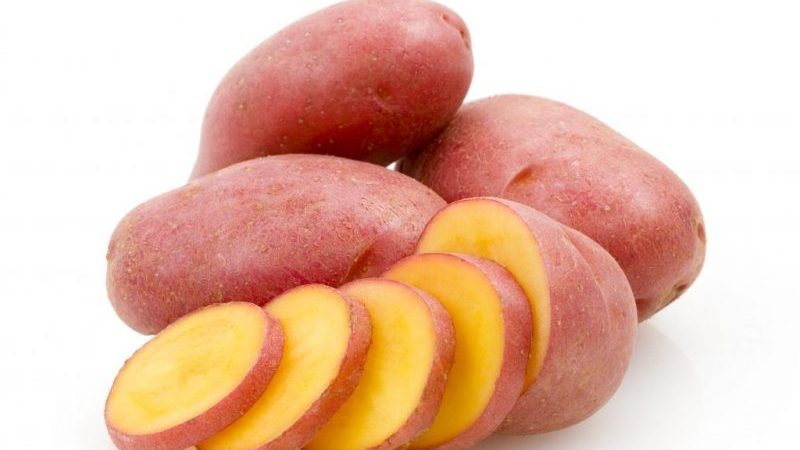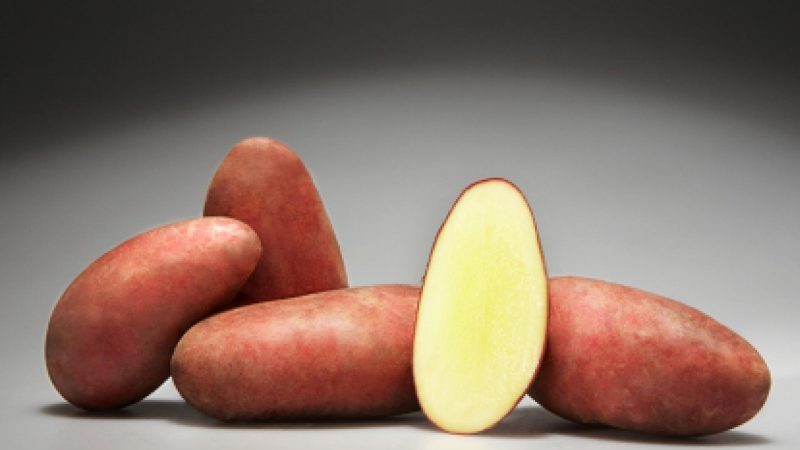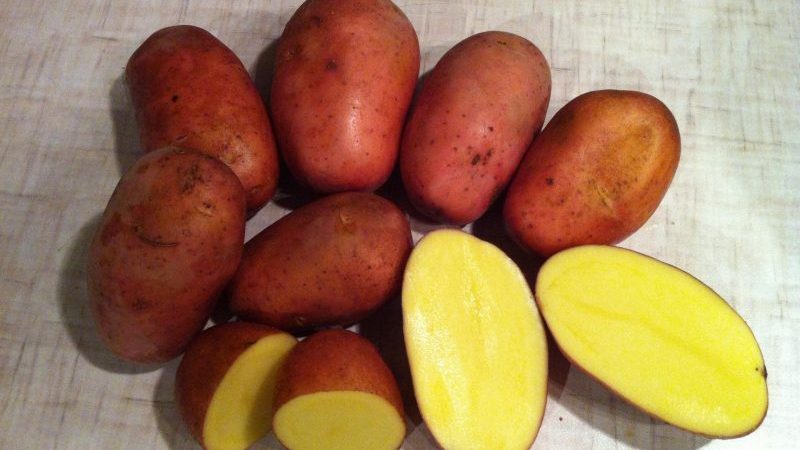Medium early potato "Rodriga" with large pink tubers
The medium early potato variety Rodriga can surprise even the most experienced gardeners. High yield, unpretentious cultivation and care, excellent taste ensured him the recognition of European, and then Russian summer residents. What are its main advantages and features, you will learn from the article.
The content of the article
Description of the variety
Rodriga is a medium-early variety of table potatoes with a growing season of 70-85 days. In the photo it looks like this:

Origin and development
The variety was bred in Germany. The author is the German company Solana GmbH & Co. KG ". Due to the large number of advantages and minor disadvantages, this European variety has become popular in Russia as well. Our people usually call him "Rodrigo".
Chemical composition, trace elements and vitamins
Rodrigues potatoes are rich useful substances. It contains potassium, calcium, carotene, phosphorus, vitamins A, B, C. Carotene acts as an antioxidant.
And here solanine Is a substance poisonous to humans. It accumulates in potatoes when exposed to sunlight and gives the tubers a green tint. It is also found in greater concentration in aboveground potato berries.
Attention! It is better not to eat green tubers.
The starch content in this variety is 12.5-15.4%.
Characteristics of tubers, description of appearance and yield
The tubers of Rodrigues potatoes are oval in shape with a smooth surface. The eyes are small, barely visible and shallow. The skin is smooth or slightly rough to the touch, pink or reddish in color. The pulp is light yellow, does not darken during cooking.
Rodrigues bushes are high, reaching a meter in height. The leaves are spreading, medium-sized, not pubescent, wrinkled, with a wavy edge. The flower petals are red-violet in color. When ripe, the tops turn yellow and lie on the ground.
Usually 7-9 tubers weighing from 200 to 800 g grow under one bush, they are almost never found smaller. The yield of the variety is high - up to 600 kg of tubers are harvested from one hundred square meters.

For which regions is it suitable
Regions in which Rodriga's potatoes give high yields on an industrial scale are Central, Volgo-Vyatka, Middle Volga, North Caucasian and Far Eastern.
For personal consumption, the variety is grown throughout Russia. Even in regions that are considered “areas of risky tillage,” it produces a good harvest.
What is the difference from other varieties
In the warm conditions of the Krasnodar Territory, the variety can produce two harvests per year. The first time sprouted tubers are planted in March, hilling to protect against frost. They are dug in late May or early June.
Reference. Compared to other varieties of potatoes, Rodriga contains less starch, and the percentage of keeping quality is higher.
The second time the remaining tubers of the spring or last year's harvest are planted at the end of August, and dug out at the end of October - beginning of November.
The main advantages and disadvantages of the variety
The positive qualities of Rodrigues potatoes include:
- undemanding to soil;
- disease resistance;
- high productivity;
- high keeping quality during winter storage;
- excellent taste;
- ability to resist damage;
- ease of care;
- presentable appearance.
The conditional disadvantages include the large size of the bush, which requires an increased distance between the beds. Tubers of this variety do not like waterlogged soil and can rot during the rainy season.
Features of planting and growing
Rodriga potatoes are not picky about growing conditions and show good yields in any weather. To get the best result, we advise you to familiarize yourself with some of the nuances.
Preparing for landing
Almost any type of soil is suitable for growing the Rodriga variety. Before planting, organic and mineral fertilizers are introduced into the ground - for example, humus.
For a good harvest, it is important to choose the right planting site. A rich harvest of potatoes will be in a sufficiently illuminated place, where root crops, legumes, onions, cabbage, and cucumbers previously grew.
For seed, an egg-sized tuber is considered the ideal size. Also, the seed of this variety can be cut.
Before planting, it is advisable to germinate the tubers in a warm and bright room. If they wrinkle, water is sprayed on them.
Before planting, tubers are treated with growth stimulants and pest drugs. But this is optional.
Timing, scheme and landing rules

Rodriga potatoes are planted from the end of April to May, depending on the region, when the soil warms up to + 8-10 ° C, and the air temperature to + 18 ° C. This time is easy to determine, as dandelions and lilacs bloom. So that the seedlings do not fall under frost, they wait until the end of the flowering of the bird cherry.
When planting in the holes, a pinch of wood ash or mustard powder is added to fight the nematode. The tubers are sprayed with a solution of copper sulfate.
Planting material is buried to a depth of 10 cm if the soil is light, and 5 cm if it is heavy. After that, the beds are watered a little, about half a liter per bush. To protect against sudden frosts, the rows are sprinkled with mulch.
Growing features
Not too many flowers are formed in this variety, and they do not need to be cut off, so as not to cause stress to the plant.
In order to prevent the growth of weeds between the potato bushes, deep loosening is carried out. This is especially necessary after rain. Rodriga does not like herbicides from weeds and can slow down its growth.
To strengthen the tubers, the bushes are watered with calcium nitrate at the root twice a season. Although this variety is resistant to pests and diseases, preventive insecticide treatment will not hurt.
The nuances of care
The main stage of caring for the Rodriga variety is hilling bushes. The first time the procedure is carried out when the planting grows to 10 cm in height. Almost all the green mass is covered with earth, a small part of 2-3 cm is left on the surface.
The next time hilling is necessary when the left tails grow 10 cm.
The third time, the procedure is carried out with the foliage completely closed.
It is also required to loosen the soil between the rows more often so that the dense soil does not interfere with the formation of potatoes. It is easier to do this after watering or rain.
Watering mode
Water the plantings abundantly, but infrequently. During the season, three good irrigations are enough for the depth of soil moisture to be 20-25 cm. The spreading leaves of this variety retain soil moisture for a long time. Watering is carried out by the drip method or simulates rain.
Top dressing
Before planting, manure is applied in the fall or spring one and a half months before planting the tubers.
It is helpful to add some wood ash just before planting.
For feeding planted potatoes use mineral fertilizers - for example, potassium chloride, superphosphate, and organic - urea, wood ash.
Top dressing is applied three times: during the growth of greenery and stems, during the formation of buds and in the flowering phase.
Disease and pest control
Rodriga variety is disease resistant. The main pest is the Colorado potato beetle. You can try to scare him away with folk remedies. For example, a beetle does not tolerate the smell of garlic and calendula planted nearby. Of the chemical agents, spraying with drugs is used: "Prestige", "Octara", "Corado" and others.
Attention! All treatments are stopped one month before harvesting.
Harvesting and storage

Since Rodriga potatoes are considered a medium early variety, they cannot be kept in the ground for long.
How and when to collect
Tubers of this variety are dug out as soon as the tops turn yellow and dry. The harvested crop is dried within 24 hours. If long-term storage is expected, then the drying time is extended to 2-3 days.
When the tubers are dried, they are cleaned of dirt and stored.
Storage features and keeping quality of the variety
The Rodrigue variety is not particularly picky about storage conditions. The main thing is that the tubers are clean and dry. A ventilated room is suitable for storing crops, where the temperature does not exceed + 3 ... + 5˚С, and the humidity is maintained at 75-85%.
The tubers of this potato lie perfectly until spring, they begin to germinate just before the onset of heat.
What can be the difficulties in growing
Rodriga potatoes are grown in all climatic zones of Europe. The variety shows good results in the northern and southern regions, although it is recommended for cultivation in subtropical conditions. Rodriga is not afraid of heat, drought, or coolness.
The success of cultivation is confirmed by summer residents who cultivate this potato in areas with different weather conditions.
Tips from experienced gardeners and reviews of the Rodriga variety
Gardeners mostly leave positive reviews about the Rodriga potato variety.
Larisa, Balashikha: «First grown potato variety Rodriga, or, as we called him, Rodriguez. When landing the tubers had to be cut into 3 pieces. Grown, like other varieties, only dug up earlier. All tubers turned out to be about the same, the taste is excellent! "
Alexander, Tver: “Our family is very fond of the Rodrigo potato variety. Of course, you have to fight with the Colorado potato beetle, but the rich harvest is worth it! Our secret is that we germinate tubers in plastic bags. "
Valentin, Belgorod: “This undemanding variety endured the hot summer perfectly, the harvest appeared in 70 days, and this is on not very rich soil! It keeps well, even if the tubers are damaged by a shovel. "
Conclusion
Rodriga's mid-early potatoes are popular with gardeners. Its demand is due to its excellent taste, high yield, easy care and unpretentiousness to climatic conditions. The variety of German origin yields a good harvest even under minimally favorable circumstances. Try and you land Rodrigue on your site!